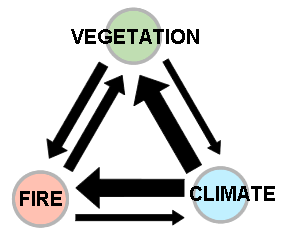Climate, vegetation & fire
Climate, vegetation and fire are inextricably linked. The conceptual diagram below expresses the strength and direction of the relationship between these elements through the thickness and direction of the arrows.

Strength and direction of the relationship between vegetation, fire and climate
Within any given biome, local-scale differences in climate and vegetation will result in differences in the prevailing fire regime.
Climate affects vegetation
Climate plays a key role in determining what vegetation types are possible at a given place. For example, if the weather is hot and wet through most of the year, tropical rainforest may develop. However, if there is a dry period each year, savannas or grassland will be the predominant vegetation type.
Activity: Vegetation types & flammability
How do different vegetation types differ in their global flammability?
Have a look at the world map shown on the inside cover of Bond & van Wilgen (1996). This shows the world biomes but also indicates which are considered flammable and which are less flammable.
The following link Earth Floor - Biomes has useful descriptions of some of the major biomes.
Reading:
Bond, W.J. & van Wilgen, B.W. (1996) Fire and Plants. Chapman & Hall, London.
Climate affects fire
Climate also directly affects how likely it is that vegetation will burn — both in the long term, and seasonally. Fires are most likely to occur after a dry period, in hot, windy weather, when humidity is low. These conditions produce hot, intense fires.
Lightning is another critical climatic factor. Local topography can result in formation of large unstable air masses and thunderstorms.
Activity: Lightning & wildfires
Where in the world is lightning most likely to strike?
Lightning was, in most places, the only ignition source before humans started to use fire. In some areas, particularly those that are sparsely populated and remote, it can still be an important source of wildfire.
Visit the following website Where Lightning Strikes to see which parts of the world experience the highest number of lightning strikes.
Did you notice that there is a very high density of lightning strikes in central Africa? That is because this area receives thunderstorms all year round.
Lightning ignites many of North America's late-summer wildfires, while people start many of the wildfires in South America. If they receive similar amounts of lighting strikes, why are most fires in South America started by humans? It's simply because lightning in South America happens during a season when the ground is damp. Lightning in North America strikes mostly during the dry season when the ground is dry and littered with ready fuel for fires.
So, if rainfall is frequent and reliable, and fuels stay damp, fires will occur rarely, if at all; tropical rainforest can only be burnt during unusually dry periods. Severe drought in Indonesia and New Guinea in 1996/1997 allowed fires to burn over vast areas of rainforest. Conversely, where there is sufficient vegetation and fuel load development, and frequent, prolonged dry periods, frequent fires will result.
Fire and vegetation
Fire, in turn, affects vegetation. Fire can be very damaging to rainforest vegetation because most rainforest plants are poorly adapted to fire. Savanna plants and animals, by contrast, are well able to tolerate fire. Some wetter savannas would be replaced by rainforest were it not for regular fires, most of which are lit by humans.
Hot topic activity: a world without fire
What would the world look like without fire?
The role of fire in transforming landscapes is highlighted in a paper by Bond et al. (2005), who pose the question, what would the world’s vegetation be like without landscape fire? How important is fire in shaping the landscapes we see today?
This paper describes the development of vegetation models based on plant physiological properties using climate data, soil properties and atmospheric CO2 concentrations. These mechanistic models were used to predict composition and structure of vegetation for a given climate in the absence of fire. They then used empirical relationships between moisture content of plant litter (estimated from climate data) and fire return intervals to simulate the resulting vegetation types.
Pay special attention to the introduction, Figures 5 and 6, the discussion and the conclusion. Don’t worry too much about the details of the modelling, or the fine details of the South African example.
Which biomes are most prone to fire? Why do you think this is? Which areas of the world are most modified by fire, at least in terms of tree cover?
Reading:
Bond, W.J., Woodward, F.I. & Midgley, G.F. (2005) The global distribution of ecosystems in a world without fire. New Phytologist 165: 525-538.
Vegetation affects fire
There are a range of vegetation types across northern Australia from mesic savannas to grasslands to rainforest patches. The occurrence of these vegetation patches is related to gradients of rainfall, productivity and differences in soil types that exist across northern Australia. Importantly, vegetation in these different climatic and edaphic zones is not subjected to the same burning regime nor do they have the same response to fire, nor are they equally flammable.
Activity: Plant communities and fire
How do fire regimes differ across vegetation types?
The characteristic response of different plant communities to fire is discussed in Savanna Burning.
Have a look at how fuel loads and fuel types vary, and how response to fire regime differs across vegetation types?
Reading:
Dyer, R., Jacklyn, P., Partridge, I., Russell-Smith, J. & Williams, R. (2001) Savanna Burning: understanding and using fire in northern Australia, pp.36-37. Tropical Savannas CRC, Darwin.